Tested: 2022 Porsche 911 GT3 PDK Rockets to 60 in 2.7 Seconds
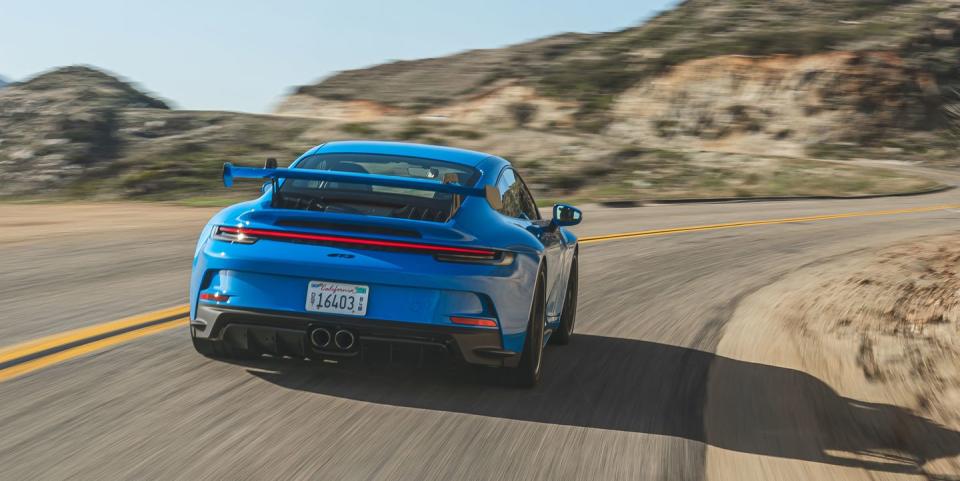
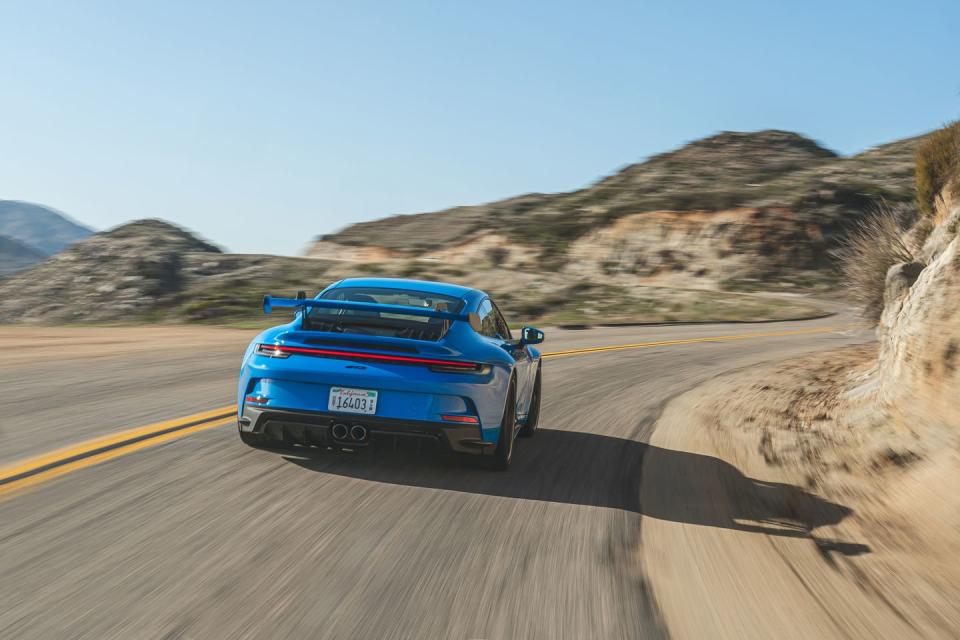
UPDATE 6/1/21: This review has been updated with test results.
From the June 2021 issue of Car and Driver.
Naturally aspirated is the new air-cooled. Just as the efficiency and proliferation of water cooling squeezed out air-cooled engines, the popularity of turbochargers is bringing an end to naturally aspirated engines. Like the final air-cooled flat-sixes, Porsche's latest naturally aspirated flat-six, with its distinctive sound and feel, seems marked for extinction. To showcase this special engine, Porsche is putting it exclusively in the new-generation 911 GT3, which costs about $18K more than the last. That's a big number to rationalize to your accountant, so here's what you say:
The latest GT3 is a winged distillation of what makes a sports car great to drive. Taken as a whole, it offers a 180-proof experience, an intoxicating, thrilling adrenaline-jag reminder of what a driver-focused car powered by a sizzling engine can do to our senses.

Quick, linear reactions are a signature of the best naturally aspirated engines, and the GT3's spins up as if unencumbered by a flywheel. Bolted into the back of the car with the new-gen 911's revised mounts, the high-revving 4.0-liter flat-six is closely related to the limited-production 911 Speedster's engine. As in the Speedster, each cylinder has a throttle body to enhance the engine's breathing and response.
An exact, almost rheostatic command of the throttles and the ability to kiss 9000 rpm are why this engine exists. If you're not into wringing out engines or you prefer a heartier low-end shove, Porsche will gladly draw up the paperwork on a 911 with a turbocharged flat-six. You'll undoubtedly live a boost-filled, happy life, but somewhere in the back of your mind will be the gnawing question of what those jerks in the GT3s are up to.
What they're up to is 502 horsepower at 8400 rpm and the music of intake noise. Pumping fake or real engine sounds into the cabin has become a thing because turbochargers inhibit the characteristic growl of an intake. Engineers and product planners understand that this is what sports-car customers want to hear, so they head into the studio and lay down some electronic tracks to simulate it. No fakery is needed in the GT3. To save 26 pounds, Porsche removed the rear seats and some sound deadening, but the real benefit is a front-row ticket to the flat-six's guttural chortles, which build to a 99-decibel sawing whine as you approach redline. An exhaust 22 pounds lighter than its predecessor sings backup with a deep, bass-filled roar. It barks, snarls, and shouts "Move! I am a race car!"
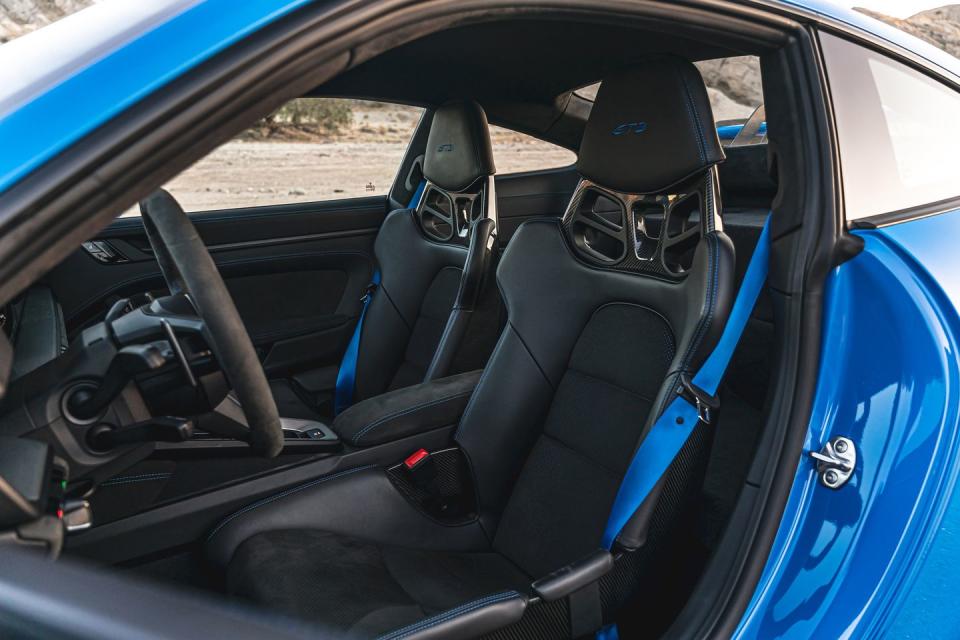
Dual-clutch automatic buyers get launch control and the ability to crack off consistent 2.7-second runs to 60 mph. The 6500-rpm launch is perfectly orchestrated violence. With 60.5 percent of the weight over the drive wheels and more shifting rearward as the car thrusts forward, the GT3 just grabs and goes.
Compared with the regular 911's automatic, which has eight speeds, the GT3's has seven and is 40 pounds lighter. It is closely related to the last GT3's, which allowed Porsche to carry over the more conventional shift lever instead of the eight-speed's goofy electronic toggle. Not only do you get to grip it and rip it in manual mode, but the shifter itself looks like it belongs to a manual gearbox, which is sure to fool at least a few of the curious folks who peer through the window.
Although it's possible to select gears via the shifter or steering-wheel paddles, the automatic is programmed with infallible situational awareness that always puts it in the right one. Just as you'd do with a manual, the automatic downshifts under braking to prepare you for an upcoming corner, and it'll hold off on upshifts if you're working hard. When an auto is this good and does exactly what you'd do, it removes some of the disappointment of not being able to master your own shifts or heel-and-toe.
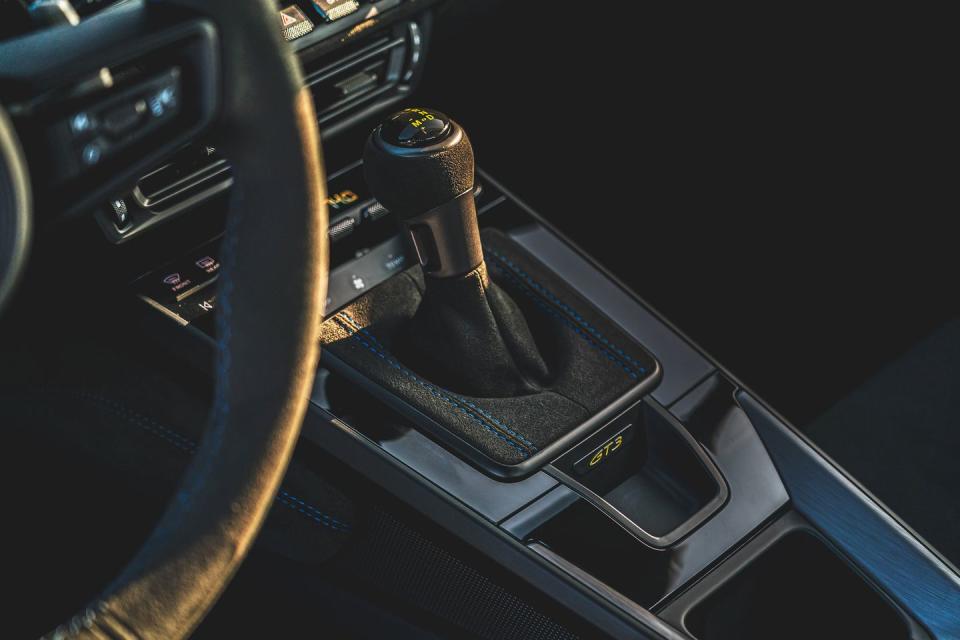
Fortunately, a six-speed manual remains optional. In the last generation, manual cars accounted for 70 percent of American sales. According to Porsche's numbers, the three-pedal version adds 0.5 second to the new GT3's time to 60, a minor penalty for what will likely be greater driver involvement—and greater involvement is what this car is all about.
Like a siren song, the incredible flat-six has distracted us from discussing the big changes to the GT3's front suspension. Bolted to the 992 generation's wider front end and unique to the GT3 is an unequal-length control-arm setup made of forged-aluminum components. Control arms are nothing new, and their advantages over a strut are well known. Adding an upper control arm reduces friction, keeps longitudinal forces from affecting the dampers, stabilizes the tire under cornering load, and minimizes brake dive without using stiffer springs.
Wider Michelin Pilot Sport Cup 2s are fitted all around, and the rear wheels grow an inch in diameter. Porsche sent us a GT3 on the stickier, dealer-installed Cup 2 Rs. Grip on the skidpad comes in at 1.11 g's, but it's the way the GT3 conquers turns that will impress even a prior GT3 owner. Turn-in is sharp but without nervousness or edginess. A standard rear-steering system is tuned to keep the big 315/30ZR-21 Michelins working in concert with the 255/35ZR-20s in the front, shrinking or stabilizing the car depending on your cornering speeds. Even as you exceed the lofty cornering limits, the GT3 lets go with a gentleness that puts you at ease. Keep adding speed; there is no fazing the GT3.
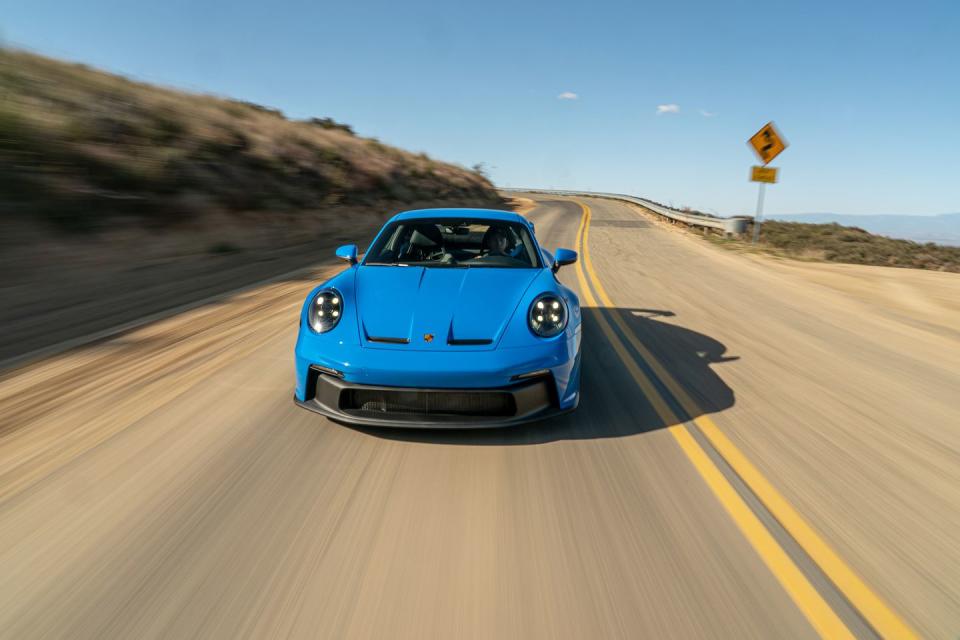
Ball joints replace most of the rubber in the suspension. Little vibrations that would be absorbed in a normal 911 ripple through the steering and right past the light padding of the $5900 Full Bucket seats. You're suddenly keenly aware of the size and shape of the aggregate used in the asphalt rolling underneath—definitely a medium, coarse, rounded granite with notes of limestone. The vibes aren't annoying either. They enhance the connection between you and the car.
The standard adaptive dampers keep the feedback from becoming too harsh. Revalved and reprogrammed, they can take a bit of the sting off cracked, lumpy pavement provided you leave them in their least aggressive setting, Sport. Switching to Track mode moves you up on the damping curve and will jiggle your untoned bits on concrete freeways. You're better off in Sport, since the suspension automatically firms up in response to cornering loads, wheel travel, and body motion.
All of those changes culminate in the best steering feel of any car on the market. Kicks from the pavement course through the helm and offer a detailed picture of the Michelins' stress levels. There's so much information going into your hands, it seems like there's no assist at all.
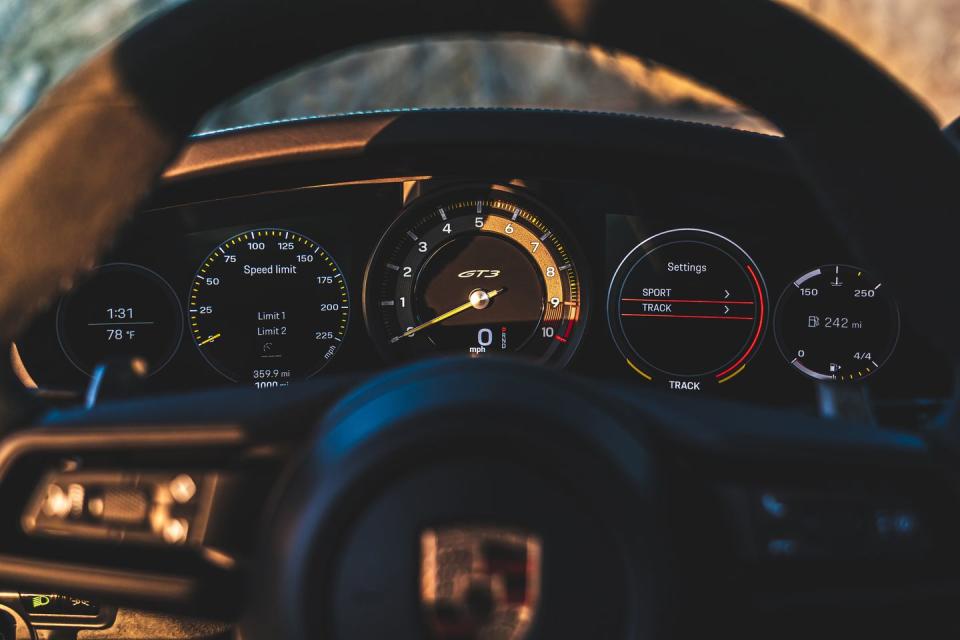
Look through the rearview mirror and you get an eyeful of the manually adjustable carbon-fiber wing, which blocks out model-identifying features of following cars like a black bar in a medical textbook. The new airfoil and the rear diffuser increase downforce by up to 150 percent over the last GT3. A wingless Touring version is in the works, but unlike the last, it'll offer a dual-clutch automatic or a manual transmission.
In keeping with the car's upgraded power and suspension, Porsche fits the GT3 with correspondingly giant brakes. The standard rotor size grows to 16.1 inches in front and 15.0 in back, nearly as large as the $9210 carbon-ceramic discs on our car. Designed for merciless track use, they never showed any signs of distress or fade. Be sure to check your six before you go hard on the brake pedal. The GT3 stops from 70 mph in a mere 133 feet and from 100 in 262.
Some rearward blindness aside, the rest of the GT3 bumrushes your senses. Perhaps it's best to think of it as a communication device, a rolling conduit stripped of the things that muddy the rapport between car and driver, but masterfully tuned and edited to keep it from going full race car. Appreciate the sharpness of the engine, the naturally aspirated flat-six canto, the padding of the seat, the physical rawness of the steering and chassis, and the way each element blends to heighten your awareness of the moment, big speeds, g-forces, and these miraculous machines that harness the combustion of long-chain hydrocarbons. Raise your consciousness while you raise hell.


You Might Also Like

 Yahoo Autos
Yahoo Autos 